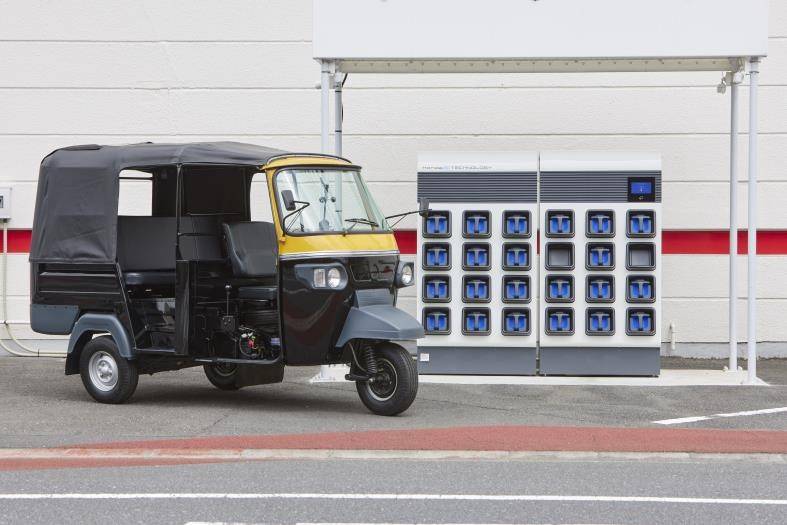Honda To Start Testing Battery For Its Upcoming Electric Scooter
Modified On October 29, 2021 15:36 IST
By Praveen M. for Honda Activa e
- 2063 Views
The Japanese manufacturer intends to test its swappable batteries on auto rickshaws first
- Honda will be using the Mobile Power Pack e (MPP e), a swappable battery system that’s versatile enough for a variety of applications.
- The company will work with electric rickshaw makers, and will establish swap stations in select cities first.
- This move helps the Japanese company to endurance-test the battery pack before implementing it on its upcoming electric scooter.

Honda has announced that it will commence battery sharing service for electric auto rickshaws in India from the first half of 2022. For this, the company will be using swappable lithium-ion battery system, the Honda Mobile Power Pack e (MPP e). You might wonder, why auto rickshaws? Well, this is a great way for Honda to test the endurance of the swappable battery system. Afterall, the company will be using the same battery to power its upcoming Honda electric scooter, scheduled to be launched in the next financial year.
The Japanese manufacturer will be creating a subsidiary that will oversee the establishment of battery sharing service and setting up of swap stations in select cities. The company says it will work with electric rickshaw manufacturers and commence the battery sharing service in select cities first, followed by a stage-wise expansion to other cities.

The electric rickshaw driver can simply go to the nearest swap station and exchange the depleted battery pack with a new one and can continue operating the rickshaw. This essentially minimises the down time for an electric vehicle to charge to a great extent. The battery pack will be made in India, and weighs 10.3kg, making swapping fairly easy. It takes about five hours to charge, and the range depends on the kind of motor the electric rickshaw uses.
In fact, Honda has already tested this arrangement back in February 2021, when it tested 30 electric rickshaws driven for over 2 lakh km. This has helped Honda to study how viable its battery packs are business-wise, and also how the batteries perform in a demanding country like India where the weather is often extreme, traffic is heavy, and roads often not-so-well-made.

Commenting on the initiative, Minoru Kato, Chief Officer, Life Creation Operations, Honda Motor Co., Ltd., said, “Honda Mobile Power Pack (MPP) has huge potential to electrify all kinds of devices including small-sized mobility products and expand the use of renewable energy. By offering a battery sharing service in India, Honda will contribute to the accelerated electrification of rickshaws and expanded use of renewable energy. Moreover, Honda will continue serving people worldwide with the joy of expanding their life’s potential by further expanding the utilization of the MPP into broader areas.”
- Honda CRF150L ADV Updated With New Colour Schemes
- EXCLUSIVE: Yamaha R15S Launch Soon
- Bajaj Pulsar F250 vs Pulsar 220F: Differences Explained
The Mobile Power Pack was first unveiled in 2017, designed to be versatile enough for a variety of applications (apart from usage in electric vehicles), including portable power supply, and power storage in homes. The core idea of this system is to charge the battery pack through renewable energy sources, and then use the battery for different purposes. This helps in making the usage and distribution of renewable energy much better. The MPP e is an improvement over the first generation battery, with a rated capacity of 26.1Ah/1314Wh.

All said and done, it’ll be interesting to see what kind of energy sources the company will use to keep the battery sharing network powered up. This is especially considering the electricity sector in India is the biggest consumer of raw coal (64.86%) and lignite (85.96%) as of financial year 2019-20, according to the Ministry of Statistics and Programme Implementation, Government of India. That means, most of the electricity produced in India comes from non-renewable resources.
Either way, testing the battery’s capabilities on commercial vehicles first is a smart move by Honda as it serves as a perfect platform to realistically simulate the battery’s usage in Indian conditions. This also minimises the need for Honda to test the batteries in real-time on the final product. Nonetheless, the Honda Benly e, a commercial scooter that uses the MPP e, was spotted testing back in June. You can read more about it here.
